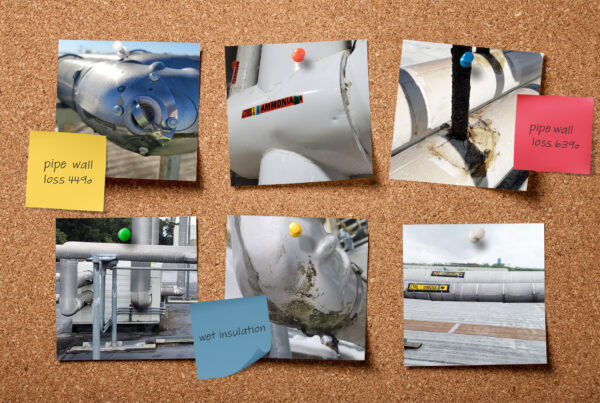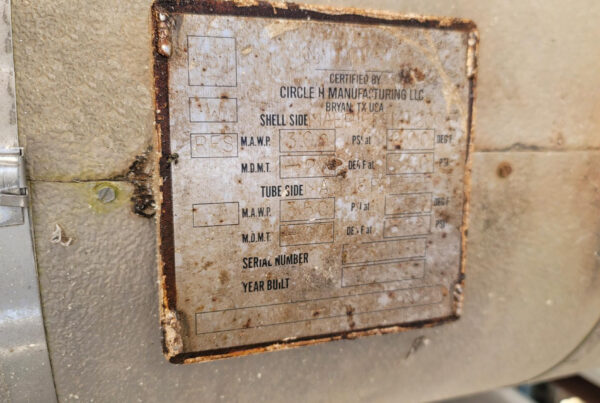Managing Your Record Keeping Activity Post-NDT
Record keeping, like many of the requirements that fall within PSM and RMP standards, maintains a general outline that lacks real guidance. IIAR-6 makes an attempt at recommendations for execution with its ITM (Inspection, Testing, Maintenance) framework, though there is still plenty of grey area. Therefore, it is not a surprise we are often asked by our customers to offer input on how they should manage their documentation post-testing.
Here we offer facts and observations to help assist in the organization and implementation of Non-Destructive Testing (NDT) related record keeping that complies with governing programs based on the published standards and best practices of our customer base.
1. Your NDT Report – What It Is and What It Is Not
Your NDT report documents all findings from the evaluation of specific locations in your system, to comply with the Process Hazard Analysis (PHA) and Mechanical Integrity (MI) requirements within the standards. Testing commonly employs calibrated instruments, devices, and/or gauges to determine the operational status of the equipment or component, typically piping and vessels.
The report should be a kept record for proof the activity of testing occurred, and to substantiate or repudiate the integrity of the equipment or components tested. While it will provide data necessary for decision-making by detailing the state of the equipment or component at the time of testing with quantitative metrics, it does not provide recommendations for action or otherwise.
The results of NDT, including the analysis, findings, or quantitative data, should only be revised by the author in very specific circumstances. Some reporting will provide a dedicated addendum function for record keeping that does not interfere with the reporting data. However, Stephanie Smith, PE, of Risk Management Professionals instructs, “an owner’s notes penned on printed documentation for PHA or Process Safety Information (PSI), such as a non-destructive testing report or P&IDs, for example, must be formalized as a new record or in a log within a 6-month timeframe.”
Per 1910.119 (j)(4)(iv), the documentation (report) shall identify the date of the inspection or test, the name of the person who performed the inspection or test, the serial number or other identifier of the equipment on which the inspection or test was performed, a description of the inspection or test performed, and the results of the inspection or test.
The contents of the report will differ depending on the provider you employ, the technology they use, and the scope of the testing project. At a minimum, each location tested should have information that allows you to decide if the piping or vessel (at the area tested) is fit for service. When a tested location is not fit for service, or requires attention, the next steps will become part of the separate but related documentation.
2. Record Keeping Requirements Included in the Standards
Documentation
To comply with PSM and RMP, the records you must keep related to inspection, testing, and maintenance activity are to be included with your PHA documentation and MI procedures.
Process hazard analysis documents should be recorded in priority order with rationale for conducting the analyses. This should include copies of the process hazard analyses, team members, actions to promptly address findings, written schedules for actions to be completed, documentation of resolution of findings, documentation verifying communication to appropriate personnel, and 5-year revalidation of original PHA required by standard.
Mechanical integrity procedures are written procedures and schedules to maintain the ongoing integrity of process equipment; the relevant portions of applicable manufacturers’ instructions, codes, and standards; and inspection and tests performed on process equipment in the unit(s) selected.
These directives are derived from the general requirements noted in OSHA’s Process Safety Management (PSM) of Highly Hazardous Chemicals Standard and General Duty Clause, the EPAs Risk Management Plan (RMP) Rule and the ANSI/IIAR 6-2019 Standard for Inspection, Testing, and Maintenance of Closed-Circuit Ammonia Refrigeration Systems (IIAR-6).
IIAR-6 defines documentation as:
Material that provides details of information, facts, knowledge, official confirmation, evidence, or a combination thereof that is conveyed or represented by an arrangement or sequence and can serve as a record. It includes data that are accurate and timely; specific and organized for a purpose; presented in a context that gives them meaning and relevance; can lead to an increase in understanding and decrease in uncertainty; and are valuable because they can affect behavior, a decision, or an outcome.
Record keeping requirements under IIAR-6 that apply to documentation of NDT projects and follow-up activities include the following:
[5.3] The owner or owner’s designated representative shall ensure a record keeping system is established and maintained to provide evidence that the provisions of this standard have been implemented and to address identified deficiencies.
[5.3.2] *Inspection, testing and maintenance records shall be readily accessible, whether filed at the facility, offsite, or electronically.
[5.3.6.1] *A means of record keeping, such as a log, to document and transfer pertinent operational, maintenance, and ongoing duty information between operators shall be implemented.
Per 1910.119 (d)(3) / 40 CFR §68.65, which refers to process safety information, specifically information pertaining to equipment in the process instructs:
(ii) The employer shall document that equipment complies with recognized and generally accepted good engineering practices.
(iii) For existing equipment designed and constructed in accordance with codes, standards, or practices that are no longer in general use, the employer shall determine and document that the equipment is designed, maintained, inspected, tested, and operating in a safe manner[.]
Record Retention
The standards and code state that all PHA related documentation must be retained for the life of the process. While the code does not specify a retention period for MI, it is recommended to maintain records for 5 years. This results in independent retention policies, one for maintenance, and one for inspection and testing.
Further, IIAR-6 offers a normative [Table 5.3.7] Retention of Records instruction with straightforward independent polices:
| Type of Record | Retention Duration |
| Daily Inspection Records | Most current 12 months. |
| Daily Testing Records | Most current 12 months. |
| Daily Maintenance Records | Most current 12 months. |
| Annual Inspection Records | Most current 5 years. |
| Annual Testing Records | Most current 5 years. |
| Annual Maintenance Records | Most current 5 years. |
| Five Year Inspection Records | Two (2) most current. |
| Five Year Testing Records | Two (2) most current. |
| Five Year Maintenance Records | Two (2) most current. |
| Ten Year Maintenance Records | Two (2) most current. |
3. Post-NDT Record Keeping Execution and Implementation
Post-NDT record keeping consists of two parts – (1) your NDT report and (2) your log or documentation that details any remediation actions for maintenance or otherwise to respond to less than acceptable findings disclosed in your NDT report.
Whether your NDT report is a printout, PDF, excel file, or data in your PSM or similar software, it serves as evidence testing was performed under the MI procedures requirement.
Actions to resolve findings can be tracked in a separate log or document as part of your PHA. It should include the issue, resolution, dates, assignments, status, and refer to related documents such as work orders, MOC, purchase orders, etc.
Example of a post-NDT Maintenance Log

Consider these simple rules for your logs:
- Include all issues found as a result of testing; tested areas that meet acceptance criteria do not get listed in a maintenance log.
- Note the planned action to resolve the issue.
- Not all issues are equal. Critical issues should be dealt with as soon as possible, less dire problems can be slated for a later date but must be included in the plan.
- Set due dates for actions.
- Meet the due dates. Do what you say you are going to do.
- Communicate the plan to your team/participating employees.
- Document how you will manage your maintenance log, and the retention policy for the log, as an MI procedure.



